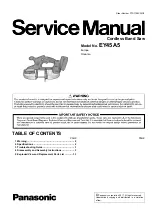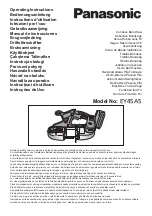
29
29
Do not use a back-and-forward sawing motion; let the chain do the
work. Keep the chain sharp and do not try to push the chain through
the cut.
Do not put pressure on the saw at the end of the cut. Be ready to take
on the weight of the saw as it cuts free from the wood. Failure to do so
could result in possible serious personal injury.
Do not stop the saw in the middle of a cutting operation. Keep the saw
running until it is already removed from the cut.
Personal protective equipment
Good quality personal protective equipment, as used by professionals,
will help reduce the risk of injury to the operator. The following items
should be used when operating the product:
■
Safety helmet
■
Hearing protection
■
Eye and face protection
■
Gloves
■
Leg protection (chaps)
■
Chainsaw safety boots
–
Occasional users may use steel toe-cap safety boots with
protective gaiters if the ground is even and there is little risk
of tripping or catching on undergrowth
■
Chainsaw jackets for upper body protection
INSTRUCTIONS CONCERNING THE PROPER TECHNIQUES FOR
BASIC FELLING, LIMBING, AND CROSS-CUTTING
See pages 23-24.
Understanding the forces within the wood
When you understand the directional pressures and stresses inside
the wood, you can reduce the pinches or at least expect them during
your cutting. Tension in the wood means the fibres are being pulled
apart, and if you cut in this area, the kerf or cut tends to open as the
saw goes through. If a log is being supported on a saw-horse and the
end is hanging unsupported over the end, tension is created on the
upper surface due to the weight of the overhanging log stretching
the fibres. Likewise, the underside of the log is compressed, and the
fibers are being pushed together. If a cut is made in this area, the
kerf will have the tendency to close up during the cut. This cut would
pinch the blade.
Push and pull
The reaction force is always opposite to the direction the chain is
moving. Thus, the operator must be ready to control the tendency
for the product to pull away (forward motion) when cutting on
the bottom edge of the bar and the push backwards (towards the
operator) when cutting along the top edge.
Saw jammed in the cut
Stop the chainsaw, and make it safe. Do not try to force the chain and
bar out of the cut as this is likely to break the chain, which may swing
back and strike the operator. This situation normally occurs because
the wood is incorrectly supported, which forces the cut to close under
compression, thereby pinching the blade. If adjusting the support
does not release the bar and chain, use wooden wedges or a lever
to open the cut and release the saw. Never try to start the chainsaw
when the guide bar is already in a cut or kerf.
Skating/Bouncing
When the chainsaw fails to dig in during a cut, the guide bar can
begin hopping or dangerously skidding along the surface of the log
or branch, possibly resulting in the loss of control of the chainsaw. To
prevent or reduce skating or bouncing, always use the saw with both
hands. Make sure that the saw chain establishes a groove for cutting.
Never cut small, flexible branches or brushes with your chainsaw.
Their size and flexibility can easily cause the saw to bounce towards
you or bind up with enough force to cause a kickback. The best tool
for that kind of work is a hand saw, pruning shears, an axe, or other
hand tools.
Felling a tree
See figures 1 - 8.
When bucking and felling operations are being performed by two
or more persons at the same time, the felling operations should
be separated from the bucking operation by a distance of at least
twice the height of the tree being felled. Trees should not be felled
in a manner that would endanger any person, strike any utility line, or
cause any property damage. If the tree does make contact with any
utility line, the company should be notified immediately.
The chainsaw operator should keep on the uphill side of the terrain as
the tree is likely to roll or slide downhill after it is felled.
An escape path should be planned and cleared as necessary before
cuts are started. The escape path should extend back and diagonally
to the rear of the expected line of fall.
Before felling starts, consider the natural lean of the tree, the location
of larger branches, and the wind direction to judge which way the
tree will fall.
Remove dirt, stones, loose bark, nails, staples, and wire from the tree.
Do not attempt to fell trees that are rotten or have been damaged by
wind, fire, lightning, etc. This is extremely dangerous and should only
be completed by professional tree surgeons.
1. Notching undercut
See figures 1 - 6.
Make the notch 1/3 the diameter of the tree, perpendicular to the
direction of the fall. Make the lower horizontal notching cut first.
Cutting the horizontal notching cut first helps to avoid pinching
either the saw chain or the guide bar when the second notch is
being made.
2. Felling-back cut
See figures 1 - 6.
Make the felling-back cut at least 50 mm (2 in.) higher than the
horizontal notching cut. Keep the felling-back cut parallel to the
horizontal notching cut. Make the felling back cut so that enough
wood is left to act as a hinge. The hinge wood keeps the tree from
twisting and falling in the wrong direction. Do not cut through
the hinge.
As the felling gets close to the hinge, the tree should begin to
fall. If there is any chance that the tree may not fall in the desired
direction or it may rock back and bind the saw chain, stop cutting
before the felling-back cut is complete and use wedges of wood,
plastic, or aluminium to open the cut and drop the tree along the
desired line of fall.
When the tree begins to fall, remove the chainsaw from the cut,
stop the motor, put the chainsaw down, and use the retreat
path planned. Be alert for falling overhead limbs and watch your
footing.
Removing buttress roots
See figures 7 - 8.
A buttress root is a large root extending from the trunk of the tree
above the ground. Remove large buttress roots before felling. Make
the horizontal cut into the buttress first, followed by the vertical
cut. Remove the resulting loose section from the work area. Follow
the correct tree felling procedure after you have removed the large
buttress roots.
Bucking a log
See figures 9 - 11.
Bucking is cutting a log into lengths. It is important to make sure your
footing is firm and your weight is evenly distributed on both feet.
When possible, the log should be raised and supported by the use
of limbs, logs, or chocks. Follow the simple directions for easy cutting.
When the log is supported along its entire length, it is cut from the
top (overbuck).
When the log is supported on one end, cut 1/3 the diameter from the
underside (underbuck). Then make the finished cut by overbucking
to meet the first cut.
When the log is supported on both ends, cut 1/3 the diameter from
the top (overbuck). Then make the finished cut by underbucking the
lower 2/3 to meet the first cut.
When bucking on a slope, always stand on the uphill side of the log. To
maintain control when “cutting through”, release the cutting pressure
near the end of the cut without relaxing your grip on the chainsaw
handles. Don’t let the chain contact the ground. After completing the
cut, wait for the saw chain to stop before you move the chainsaw.
Always stop the motor before moving from tree to tree.
Limbing a tree
See figures 12 - 13.
Limbing is removing the branches from a fallen tree. When limbing,
leave larger lower limbs to support the log off the ground. Remove the
small limbs in one cut. Branches under tension should be cut from the
bottom up to avoid binding the chainsaw.
Springpoles
See figures 14 - 15.
A springpole is any log, branch, rooted stump, or sapling that is bent
under tension by other wood so that it springs back if the wood
holding it is cut or removed.
On a fallen tree, a rooted stump has a high potential of springing back
to the upright position during the bucking cut to separate the log
from the stump. Watch out for springpoles—they are dangerous. Do
not attempt to cut bent branches or stumps that are under tension
unless you are professionally trained and competent to do so.
WARNING! Springpoles are dangerous and could strike the
operator, causing the operator to lose control of the chainsaw.
This could result in a severe or fatal injury to the operator.
Cutting spring poles should be done by trained users.
OPERATION
WARNING! If any parts are damaged or missing, do not
operate the product until the parts are replaced. Failure to heed
this warning could result in serious personal injury.
Installing battery pack
See page 8.
Insert the battery pack in the product. Align raised ribs on the battery
pack with grooves in the product’s battery port.
Make sure that the latch of the battery pack snaps in place and that
the battery pack is fully seated and secure in the product before
beginning operation.
Содержание A58CHS18B4
Страница 1: ...ACS58B18 A58CHS18B4 Original instructions ...
Страница 3: ...3 3 x 1 x 1 x 1 x 1 ACS58B18 ...
Страница 4: ...4 4 C C x 1 x 1 x 1 x 1 x 1 x 1 A58CHS18B4 ...
Страница 8: ...8 8 1 2 2 1 click INSTALLING AND REMOVING THE BATTERY US ...
Страница 9: ...9 9 START STOP USING THE PRODUCT ...
Страница 11: ...11 11 4 2 1 3 ADJUSTING THE CHAIN TENSION ...
Страница 13: ...13 13 3 4 2 1 ADDING CHAIN AND BAR OIL ...
Страница 14: ...14 14 click 5 6 7 RE ...
Страница 15: ...15 15 3 4 2 1 REPLACING THE CHAIN AND BAR ...
Страница 18: ...18 18 7 85 9 8 Nm 80 100 Kgf cm 12 click 13 11 IN ...
Страница 19: ...19 19 INSTALLING AND REMOVING THE SCABBARD ...
Страница 21: ...21 21 3 4 2 1 STORING THE PRODUCT ...
Страница 33: ...ets ith of cal on hat ed ally the will ould may ...
Страница 34: ......
Страница 35: ......








































